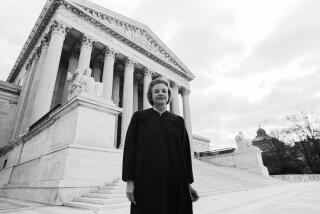Brennan’s Magic: Always Time to Talk
- Share via
NEW YORK — When Justice William J. Brennan Jr. died Thursday, there was an extraordinary outpouring of sadness crossing all normal boundaries--young and old, the legal profession and the laity, liberals and conservatives--that a titanic figure had passed from the scene.
Brennan was the most influential associate justice in the history of the U.S. Supreme Court. His opinions fundamentally altered almost every area of constitutional law. While there have been great dissenters on the court and great leaders of majorities, Brennan may have been the only justice in the court’s history to excel in both roles. Even adversaries saluted Brennan: Members of Reagan’s Justice Department had called him “the most skillful, most charming and most intelligent advocate for his activist brand of jurisprudence.”
Brennan’s powerful impact was due not only to learning and intelligence; he was also an infectious, warm-hearted person, and a good friend, as I learned over almost 40 years. I have seen many aspects of Brennan, but the most memorable may have been our first conversation, back in 1958.
I was then law clerk to an admired conservative, Justice John Marshall Harlan, but my personal views were closer to the liberal side. A case from California, Speiser vs. Randall, had come before the court in early April. In a McCarthy-era statute, the state had denied tax exemptions to World War II veterans (and others) who refused to swear that they did not advocate the overthrow of the state or federal government.
I thought the required oath was an unconstitutional tax on belief and expression, and I hoped that Brennan, to whom the opinion was assigned, would so rule. Instead, he was circulating a proposed opinion asserting the law could not be enforced because it placed the burden of proof on the taxpayers and denied them other procedural protections. This was a novel 1st Amendment theory.
In the law clerks’ lunchroom that day, I told Brennan’s clerks that I was disappointed and confused by the opinion; I intimated I would recommend to Harlan that he not join it.
Soon after lunch, to my amazement, one of Brennan’s clerks telephoned to say the justice wanted to speak with me about the Speiser case. This was unheard of--Supreme Court justices, at least in my day, did not trouble themselves with the views of clerks other than their own.
I went over to Brennan’s office and was immediately ushered in. The justice got right up from his desk and sat down on his couch with me. As he carefully explained his new 1st Amendment theories, he made me feel as if he had all the time in the world to talk to me about this. He patiently responded to each one of my concerns.
To this day, I recall not only that he convinced me about the case but also how much I personally liked Brennan, how warm and caring he was--so different from the customary formality of so many Supreme Court justices.
Looking back, I realize that Brennan was obviously, although graciously, providing me with ammunition and arguments that could be used to induce Harlan to join Brennan’s opinion. And, in due course, Harlan did decide to join Brennan’s opinion in Speiser vs. Randall.
I wonder just how much I had to do with this. But Brennan insisted on giving me credit for “persuading John,” and he referred to the incident many times.
Brennan will long be honored for his vision of law as a moral force, for his sensitive, consistent concern for the dignity of the individual, and particularly the underdog, in American society. Yet, he also will be remembered for his personal qualities--his remarkable capacity to persuade and to charm. I saw this for the first time in 1958 as a young man, and I shall never forget it.
More to Read
Get the L.A. Times Politics newsletter
Deeply reported insights into legislation, politics and policy from Sacramento, Washington and beyond. In your inbox twice per week.
You may occasionally receive promotional content from the Los Angeles Times.









